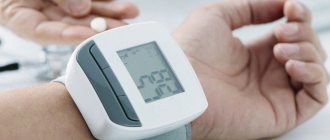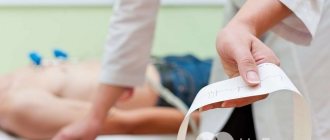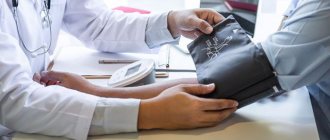Fainting (syncope) is a short-term loss of consciousness, during which muscle tone sharply decreases, then - after a minute or two - the person returns to consciousness without resuscitative measures.
There are different types of fainting, and the prognosis varies for each case. However, the essence of this condition is always that the brain does not receive enough blood, it stops working normally, and loss of consciousness occurs.
Three main types of fainting
1. Reflex (neurotransmitter) fainting occurs due to a malfunction of the nervous system and, as a consequence, vasodilation and a decrease in heart rate (bradycardia). Systemic blood pressure drops, and as a result, blood supply to the brain is disrupted. There are two types of reflex fainting:
- Vasovagal (neurocardiogenic) syncope occurs when the autonomic nervous system, which regulates blood pressure and heart rate, is disrupted. This is the most common type of fainting; it occurs especially often in athletes, young and generally healthy people. Vasovagal syncope usually occurs in a person who is standing or sitting. In this case, there is often a pre-fainting state: dizziness, lightheadedness, flush of heat, pallor, nausea, vomiting, abdominal pain, increased sweating. There is usually no cause for concern with vasovagal syncope. Such fainting can occur after a strong cough, sneezing, laughing, fright, severe pain, at the sight of blood, as well as while being in a crowded place, a hot room, in the sun, after physical exertion, urination, defecation, etc.
- Sinocarotid syncope, which occurs when pressure is placed on the carotid sinus (the dilated part of the common carotid artery). This can, for example, occur when the neck moves (in particular when a man shaves and turns his head), or if the shirt collar is too tight.
2. Fainting due to orthostatic hypotension. Orthostatic hypotension is a decrease in blood pressure during a change in position from horizontal to vertical, that is, at the moment when a person stands up. It can occur for a variety of reasons:
- from dehydration (including due to diabetes mellitus);
- with Parkinson's disease;
- after taking antiarrhythmic or antihypertensive drugs (especially in older people in the heat), antiemetics, antidepressants and antipsychotics;
- from drug and alcohol abuse;
- due to internal bleeding as a result of violation of the integrity of internal organs after injury or due to complications of various diseases;
- after standing for a long time, especially in crowded, stuffy places.
3. Cardiogenic syncope is associated with cardiac dysfunction. It can occur even when a person is lying down. Usually there are no warning signs - the person suddenly loses consciousness. This type of fainting indicates a serious threat to life and health. It occurs more often in people with a family history of unexplained sudden death or early cardiovascular disease. Fainting can be caused by:
- arrhythmia;
- ischemia (lack of blood supply) due to severe narrowing of the coronary vessels, as well as a tumor or blood clot that impairs the patency of a large vessel;
- structural changes (cardiac tamponade, aortic dissection, congenital anomaly of the coronary arteries, hypertrophic cardiomyopathy, etc.).
Sometimes fainting can be associated with hypoglycemia (too low blood glucose levels) due to diabetes, panic or anxiety disorder, etc.
A non-convulsive epileptic attack can also look like fainting, but it lasts longer than a regular faint, and after it the person does not immediately come to his senses. Also, during an attack, the patient may bite his tongue, and sometimes fecal or urinary incontinence occurs.
Loss of consciousness in some cases is caused by serious neurological disorders: stroke, transient ischemic attack, subclavian steal syndrome (deterioration of blood supply due to narrowing or blocking of the lumen of the subclavian artery), severe migraine.
Loss of consciousness after a traumatic brain injury also cannot be called fainting; in this situation, you must consult a doctor so that he can assess the severity of the damage.
In rare cases, loss of consciousness can be caused by narcolepsy, a condition in which a person experiences daytime sleep attacks and cataplexy (sudden relaxation of muscles).
How to monitor your blood pressure and control its reduction?
– In order to prevent another decrease in blood pressure, it is necessary, firstly, to determine the cause (hypothyroidism, anemia, adrenal insufficiency, taking high doses of antihypertensive drugs, etc.) and, if possible, eliminate it.
Secondly, try to avoid provoking situations and factors , observe safety conditions during verticalization, and lifestyle recommendations.
And in situations where a person anticipates developing hypotension or fainting (increased sweating, nausea), you can help yourself by using the physical counterpressure maneuvers that I described earlier.
Reproduction of CityDog.by materials is possible only with the written permission of the editors. Details here.
When should you see a doctor if you faint?
If you faint, this is not always a reason to see a doctor. For example, if nothing like this has happened before, if this is the first fainting spell in several years, then most likely you do not have any life-threatening diseases. However, there are “red flags” for the person and for those who witness the fainting, indicating that they need to seek medical help:
- fainting lasts more than 2 minutes;
- fainting occurs frequently;
- You fainted for the first time after 40 years;
- You were injured while fainting;
- you have diabetes;
- You are pregnant;
- you have had or have heart disease;
- before fainting you felt chest pain or strong or irregular heartbeat;
- during fainting, urinary or fecal incontinence occurred;
- if you start to feel short of breath.
What are the signs that indicate that my blood pressure has dropped?
– There are a lot of symptoms of low blood pressure. It can be:
- dizziness, weakness, fatigue, decreased performance, drowsiness, decreased memory, slowed reaction, decreased concentration, headaches;
- feeling of heartbeat, chilliness of the extremities;
- pallor, sweating, nausea;
- pain in the neck and upper shoulder girdle, lower back, in the heart area; hearing disorders (hearing impairment, noise or crackling in the ears);
- visual disturbances (blurredness, increased variegation, loss of color perception, narrowing of visual fields, final loss of vision).
What will the doctor do?
The doctor must understand what is the cause of fainting and whether there is a threat to life and health. To do this, he will ask about the episode itself, about the medical history, about the illnesses of relatives (especially about early heart problems), conduct an examination and do an electrocardiogram. It is very important to tell your doctor everything you felt before and after you fainted, as additional symptoms can be very helpful in making a diagnosis. For example, chest pain in some cases indicates acute coronary syndrome (myocardial infarction or unstable angina) or pulmonary embolism. Rapid heartbeat is often a sign of arrhythmia. Shortness of breath may be a manifestation of heart failure or pulmonary embolism. Headache in some cases indicates vascular disorders and hemorrhages.
Often, the patient, among other things, has a stool test for occult blood (this checks for bleeding in the gastrointestinal tract), a blood test to determine whether there is anemia, and a blood test for brain natriuretic peptide (this can indicate problems with heart). The woman will most likely be given a pregnancy test. The doctor can see how much your blood pressure and pulse change when you change your body position.
If the doctor believes that it is likely that carotid syncope has occurred, carotid sinus massage will be required to confirm the diagnosis.
If subarachnoid hemorrhage is suspected, a CT scan of the brain and a lumbar puncture may be needed.
If the doctor suspects that the problem is epilepsy, he will prescribe an electroencephalography.
If you suspect heart problems, your doctor may admit you for observation in the hospital, send you for an ECG and echocardiography, perform Holter monitoring (24-hour ECG recording), electrophysiological study of the heart, or coronary angiography. In difficult cases, an implantable (subcutaneous) loop ECG recorder may be installed for several months.
A high risk of severe consequences is indicated by:
- ECG abnormalities;
- structural changes in the heart;
- symptoms indicating heart failure (shortness of breath, weakness, fatigue, swelling, etc.);
- low blood pressure (systolic - “upper” - below 90 mm Hg);
- shortness of breath before or after fainting, or at the time of treatment;
- blood hematocrit is less than 30%;
- old age and the presence of concomitant diseases;
- sudden deaths in the family due to heart problems.
Who may have low blood pressure?
– Arterial hypotension is more common in young (under 35 years of age) women, predominantly with low body weight, who do not lead an active lifestyle, as well as in pregnant women.
Elderly and senile people (over 65 years old) with asthenia are more susceptible to postprandial hypotension (excessive decrease in blood pressure after eating. – Ed.).
In addition, low blood pressure is more often recorded in people living near busy traffic flows (railroads, highways) and in those who do not consume enough salt .
Treatment after fainting
Whether you need any treatment after fainting depends on the cause.
In case of reflex fainting, provoking factors should be avoided, since no treatment is required in this case. If you faint while your blood is being drawn, tell the nurse so they can have you lie down on the couch before pricking your finger or giving the injection. If you don't understand what exactly causes fainting, but your doctor says there is no threat to your health, you can keep a diary to determine the triggering factors.
In case of anemia, it is necessary to find out its cause and correct it: the range of conditions leading to anemia is very wide - from an unbalanced diet to a tumor.
If you have low blood pressure, it is recommended to avoid dehydration, not to eat large meals, and to drink caffeinated drinks. To prevent the pressure from dropping sharply, after you get up, you can resort to special maneuvers: cross your legs, tense the muscles in the lower part of your body, clench your fists or tense your arm muscles.
If fainting is caused by taking any medications, the doctor will stop or replace the culprit drug, change the dose or time of administration.
Some heart conditions will require surgery, including installation of a cardioverter-defibrillator (a device that monitors the heart's rhythm). In other cases, conservative therapy, for example, antiarrhythmic drugs, helps.
What foods can help with low blood pressure, and which ones should not be consumed?
– For low blood pressure, as I said earlier, it is recommended to consume large amounts of table salt (up to 10 g/day) and liquids (up to 3 l/day), and caffeine-containing drinks.
With postprandial hypotension, you need to adhere to a certain type of diet: eat often, in small portions, more proteins and fats, avoid carbohydrates (especially refined ones), eat warm or cold (not hot) foods. And you should give up alcohol.
First aid for fainting
When you feel that you are about to faint (pre-fainting or, for example, causeless yawning), lie down so that your legs are higher. Or sit with your head between your knees. This will allow more blood to flow into the brain. If you do lose consciousness, after you come to your senses, do not get up immediately. It's better to give yourself 10-15 minutes to recover.
If a person begins to lose consciousness before your eyes, follow the same instructions: lay him down so that his legs are higher than his head, or sit him down and lower his head between his knees. It is also better to unfasten the collar and loosen the belt. If a person does not come to consciousness for a long time (more than 2 minutes), lay him on his side, monitor his breathing and pulse and call an ambulance. It is not recommended to use ammonia: firstly, it is unclear whether it brings a person to consciousness faster, and secondly, it can be dangerous in some diseases, for example, bronchial asthma.
Diagnostics
The initial examination consists of listening to the patient’s complaints about the frequency and duration of fainting states, and determining the conditions under which loss of consciousness occurs. A neurological examination is performed.
The patient must be sent for laboratory blood tests.
Among instrumental studies, the most effective are:
- various types of ECG;
- echocardiography;
- computer sphygmomanometry;
- cardiac rhythmography;
- 24-hour blood pressure monitoring;
- duplex scanning of blood vessels.
These are the most modern diagnostic methods that identify the objective cause of fainting and allow you to prescribe optimal treatment.
Read also
Hepatic encephalopathy
Hepatic encephalopathy is a brain lesion that occurs against the background of liver pathology and is caused by liver failure.
There is acute hepatic encephalopathy, which occurs on… Read more
Perinatal encephalopathy
Perinatal encephalopathy is a frequently encountered concept in the practice of pediatricians and pediatric neurologists! What it is? Literally, “perinatal encephalopathy” means “damage to the brain in the perinatal...
More details
Facial paralysis (Bell's palsy/facial neuritis)
Facial paralysis is spontaneous weakness of ½ of the face. The cause is swelling of the facial nerve, as a result of its compression inside the temporal bone or in the outlet from it. Most often this leads to...
More details
Myositis
Myositis is a group of diseases characterized by an inflammatory process in skeletal muscles. Depending on the cause of the disease, there are several forms of myositis: Autoimmune…
More details
Brain concussion
A concussion is a mild traumatic brain injury without damage to the bones of the vault and base of the skull. In this condition, there are no pronounced disturbances in the functioning of the brain and there are no changes...
More details
Prevention
Knowing what to do if you faint, you also need to take preventive measures:
- eat rationally (it is better to consult your doctor about your individual diet);
- Moderate physical activity must be present;
- walk at least 2 hours a day;
- Women during pregnancy should regularly visit a gynecologist;
- eliminate extreme loads and overheating;
- Among medications, the doctor may prescribe nootropics, venotonics, adaptogens, and vitamins.











